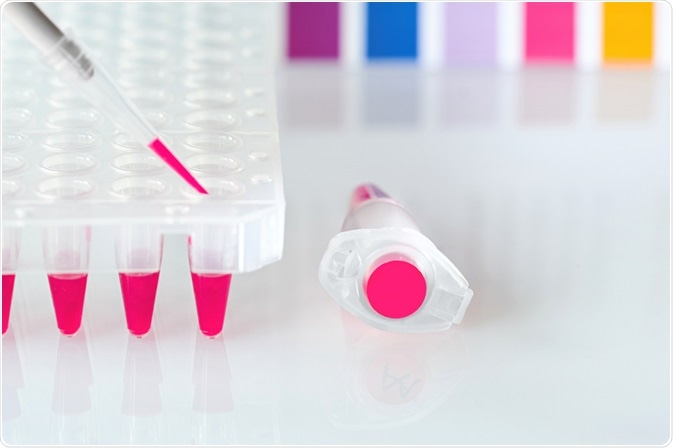Nucleic acids (i.e. DNA and RNA) can be readily labeled with various tags that enable their detection and/or purification. These labels can then be used to recover or identify other interacting molecules.
 Image Credit: anyaivanova / Shutterstock
Image Credit: anyaivanova / Shutterstock
A plethora of chemical or enzymatic methods are available to generate nucleic acids such as those labeled with fluorophores, enzymes and radioactive phosphates, or nucleotides modified with digoxygenin or biotin.
Bioconjugation methods that are employed for generating nucleic acid probes may also be adapted for attaching nucleic acids to some other surfaces or molecules to assist immobilization or targeted delivery.
Choosing an optimal method partly depends on the required degree of labeling and on whether the modification may produce the desired interactions.
Both chemical and enzymatic methods exist for generating that are labeled at the 5′ or the 3′ end of the oligonucleotide. These methods can also be used to integrate probes throughout the sequence.
When small-scale probe generation is needed, enzymatic methods present an economical approach. However, chemical methods are pertinent for larger scale production.
Chemical methods for nucleic acid labeling
Periodates are anions that are formed from oxygen and iodine, and are commonly found as salts of sodium or potassium. Aldehyde groups that are created in solutions with periodates are spontaneously reactive towards amine-containing surfaces or molecules. Thus, periodate oxidation of RNA is a common chemical method for nucleic acid labeling.
EDC or 1-Ethyl-3-(3-dimethylaminopropyl) carbodiimide is a water-soluble compound that is preferably used in aqueous reactions when the pH is between 4.0 and 6.0. EDC-mediated conjugation is an economic approach for coupling both DNA and RNA to any primary amine-containing surface or molecule.
Random chemical labeling of DNA or RNA along the length of nucleic acids is also a labeling method carried out that enables a higher degree of labeling when compared to end-labeling techniques.
However, a disadvantage of random chemical labeling is direct modification of nucleotide bases, which reduces or prevents the pairing of bases between complementary strands while hybridization experiments are underway. Hence, balancing the degree of labeling with the probe hybridization efficiency in some specific experiments is definitely warranted.
Enzymatic methods for nucleic acid labeling
DNA polymerase is an enzyme used to create DNA polymers by DNA elongation or primer extension processes.
These enzymes are used to generate nucleic acid probes by randomly incorporating modified nucleotides during DNA replication, most notably by simple primer extension procedures or by polymerase chain reactions. Such probes exhibit high specificity enabling detection of even minute quantities of the target.
Terminal deoxynucleotidyl transferase (usually abbreviated as TdT) is a DNA polymerase enzyme that is expressed in certain lymphoid cells. Usual sources of DNA templates that can be modified with TdT include single-stranded and unlabeled polymerase chain reaction (PCR) primers, as well as double-stranded endonuclease restriction fragments with 3’ overhangs.
An enzyme known as T4 RNA ligase (an ATP-dependent ligase) that stems from the T4 bacteriophage catalyzes the bonding between a terminal 5′-phosphate and a terminal 3′-hydroxyl group on the RNA molecule.
Despite the primary substrate for this specific ligase being RNA, the reaction conditions can be optimized for DNA molecules (more specifically, single-stranded DNA molecules) as well, with somewhat lower efficiency.
T4 polynucleotide kinase (abbreviated as T4 PNK), also found in T4 bacteriophage, helps in the transfer an organic phosphate from the ATP molecule to the 5′-hydroxyl group of a nucleic acid. This enzyme is template independent and can efficiently modify 5′ overhangs and single-stranded polynucleotides.
Further Reading
Last Updated: Feb 26, 2019